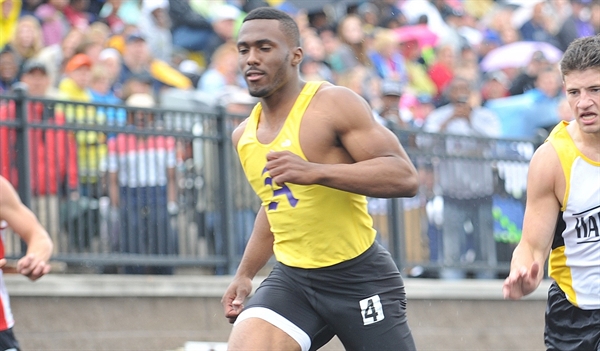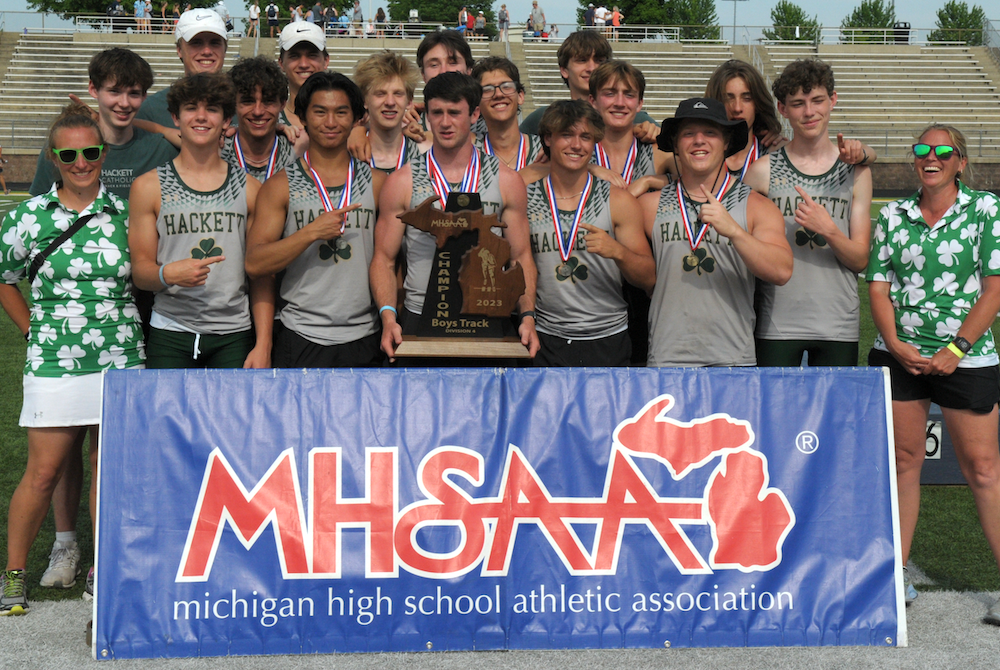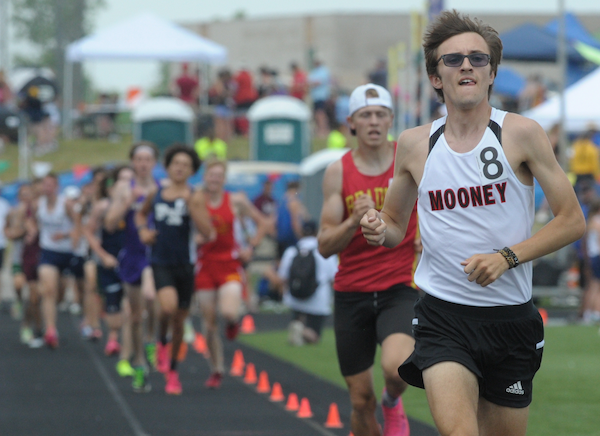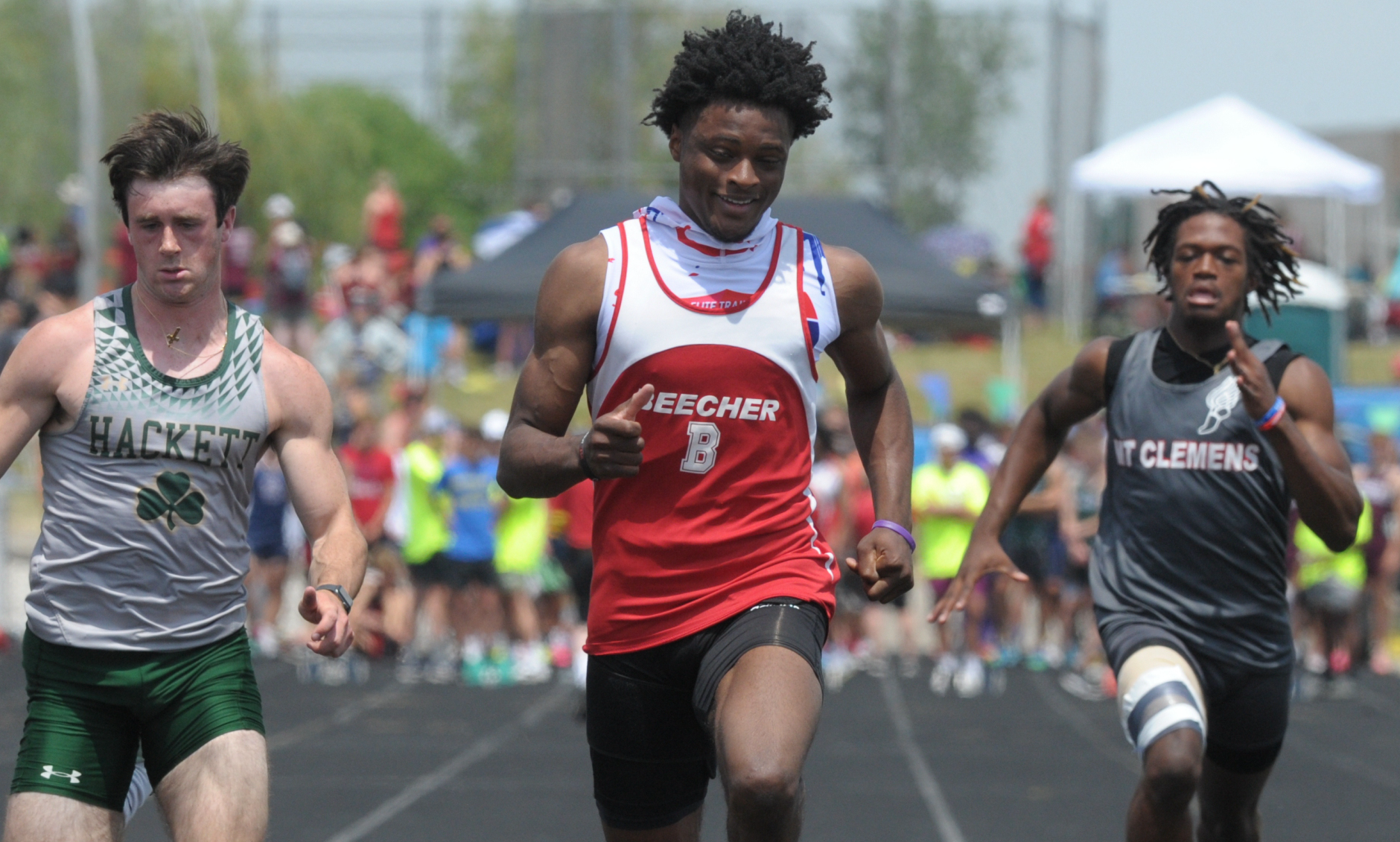
Avondale Star, St. Mary's Chase History
May 30, 2015
By Bill Khan
Special for Second Half
ZEELAND — Everyone else was chasing Joshuwa Hollomon on Saturday as he was chasing his place in MHSAA track and field history.
Hollomon became only the 10th Lower Peninsula boy in the 91-year history of the Finals to win the 100-meter (or 100-yard) dash three times in his career, finishing the feat at the Division 2 meet at Zeeland Stadium.
The Auburn Hills Avondale senior won a tight finish against Flint Southwestern Academy senior Jonathan Fife with a time of 10.71 seconds. Fife's time was 10.81.
Hollomon won the LP Division 1 title as a sophomore in 2013 before taking Division 2 his final two years.
"To win it three years, going unbeaten, I can look back and tell that to my kids one day and say, 'I did this' and have that be an influence on them," Hollomon said. "This is a great accomplishment."
Hollomon is only the third Lower Peninsula boy in the last 24 years to win the 100 three times, joining Baldwin's Jason Johnson (1995-97 Class D) and Sparta's Brandon Vandriel (2007-09 Division 2).
Hollomon also was trying to sweep the 100 and 200 in the Finals for the second straight season, but Fife turned the tables in the 200 to win in 21.55 seconds. Hollomon settled for second in 21.98.
Going into the meet, Hollomon had no idea of what to expect from Fife.
"I don't know anybody I race," said Hollomon, who will play football at the University of Cincinnati. "I don't watch them. I study myself. I know the person next to me on both sides wants to win just as bad as I do. When you get fast people, it makes you faster."
The biggest disappointment for Hollomon came in the 800 relay, as he never received the baton for the final leg because of a dropped first exchange.
While Hollomon has become accustomed to winning MHSAA championships, a school with a championship pedigree in nearly every sport except track and field won its first title.
 Orchard Lake St. Mary's scored 52 points to beat runnerup Zeeland East by 7.5.
Orchard Lake St. Mary's scored 52 points to beat runnerup Zeeland East by 7.5.
The Eaglets' best finish in an MHSAA final meet was third in Division 2 in 2006. They laid the groundwork for Saturday's championship by placing fourth last year.
"We broke six school records this year," St. Mary's coach Sean Clouse said. "We're pretty young still. We have a great group of seniors and a lot of young kids, too, so hopefully we'll be back again next year."
Six of the 14 athletes who scored for the Eaglets were sophomores, including 300-meter hurdle champion Richard Bowens. Bowens posted a time of 38.42 seconds and was also on the seventh-place 1,600 relay team.
St. Mary's won the 400 and 800 relays for the second year in a row, but was able to take the team title by having more firepower throughout its lineup. The Eaglets scored in eight events, including all four relays.
Junior Tyler Cochran was on the winning 800 relay team and took third in the 400 in 49.83 seconds. He was also on the seventh-place 1,600 relay unit.
Senior Ross Moore was on both winning relay teams and placed eighth in the long jump. Sophomore Kahlee Hamler was also on both first-place relay teams. Freshman Ky'Ren Cunningham was on the 800 relay team, while sophomore Ryan Johnson rounded out the 400 relay.
Sophomore Trey Bryan was fifth in the long jump, while senior Brian Agomuoh was seventh in the discus.
"Our long jumper surprised us a little bit," Clouse said. "We knew our relay teams were going to do well. We're just so happy with them. The sprint teams doubled up last year and doubled up again this year. Cochran in the 400 came through really big. The hurdler, Bowen, was amazing."
Cool, rainy conditions favored distance runners, but were a detriment to other athletes. Algonac senior Mitchell Mueller was able to repeat as pole vault champion by going 15 feet, 6 inches, but was left wondering what might have been under more ideal conditions. He attempted to break the LP Division 2 Final record of 16-1 set by Marine City's Jaime Salisbury in 2012, but came up short in three tries at 16-2.
"It was definitely challenging," Mueller said. "It kind of stunk that today had to be that kind of day, but I still got to go 15-6, still got a chance to go for the record. By the time we got to the chance to go for the record, it was raining pretty good. The last attempt was pretty close. It was just too much rain, not a good day. It was really cold, but it was still fun and I still had a great time."
Algonac had another champion in junior Morgan Beadlescomb, who won the 1,600 in 4:13.58. He sat on the shoulder of Cedar Springs senior Austin Sargent most of the race before making an explosive move with 300 meters to go. It was a flashback to a similar scenario in the cross country finals in November, when Beadlescomb out-dueled Sargent for the title.
"I work on my kick a lot," Beadlescomb said. "I kind of rely on that. In cross country, it was exactly the same. The last 300 meters is when I took off and won."
The host Zeeland school district had three of the top four finishers in the 800, with senior Sam Plaska of Zeeland West making his move with 100 meters remaining to overtake Sturgis junior Daniel Steele, who had opened up a large lead. Plaska won in 1:55.11, just ahead of Zeeland East's Matt Cramer. East's John Groendyke was fourth in 1:56.83.
"It's unbelievable," Plaska said. "I'm so happy to have the home crowd here, my family and friends cheering me on. It's such a great day."
Zeeland East provided some excitement for the home crowd early by setting the LP Division 2 Final record in the 3,200 relay. The quartet of Scott Binder, Dan Cramer, Matt Cramer and Groendyke won in 7:50.70, breaking Fenton's mark from 2007.
Other individual champions were Freeland's Nathan Whitting in the high jump (6-6), Melvindale's Anthony Fitzgerald in the long jump (22-5), Mason's Justin Scavarda in the discus (172-2), Coldwater's Logan Targgart in the shot put (57-3.75), Lake Odessa Lakewood's Noah Caudy in the 110 hurdles (14.70), St. Johns' Steven Linton in the 400 (49.04) and Corunna's Noah Jacobs in the 3,200 (9:27.49).
Williamston won the 1,600 relay in 3:22.98 with the team of Hunter Grischke, Seth Kerby, Steffan Smalley and Tyler Lamar.
PHOTOS: (Top) Auburn Hills Avondale's Joshuwa Hollomon rushes toward the finish during one of his championship runs Saturday. (Middle) Orchard Lake St. Mary's hoists its first MHSAA track and field championship trophy. (Click to see more from RunMichigan.com.)

Thrower Claims Lone Individual Title to Lead Hackett to Team 3-Peat
By
Tom Lang
Special for MHSAA.com
June 3, 2023
Kalamazoo Hackett Catholic Prep just keeps winning and winning.
This time the Irish took home their fourth title in the last five Lower Peninsula Division 4 Track & Field Finals, on Saturday at Hudsonville.
Hackett’s only individual title was taken by discus winner Nathan Buchmann, a senior, who was fine knowing he was the shortest in stature among all the sizable competitors.
“In the offseason after football I worked out every day, working towards this goal,” he said after getting his medal. “I would say this takes 80 percent technique and 20 percent strength to throw the discus. So, length can help but if you have good technique and are really strong, that will play into it.
“I think we are very balanced throughout the meet today,” he said about teammates that scored points in finishes other than first place. “We have 13 guys here today, and we have people in a lot of the races. But I do not run; I have too short of legs to be a fast runner,” he said with a chuckle.
Buchmann had to work through a hip injury to compete this spring.
“I think the setbacks are what make you strong,” he said. “You can either give up through the setbacks or push forward and become better.”
 Coach Charissa Dean agreed.
Coach Charissa Dean agreed.
“The kids have big hearts,” she said after all the points were totaled and the Irish were on top once again, with 53. “They worked hard. They had a lot of potential when we started the season. And we had a lot of drive to put in the work, and we are happy the results came out the way they did.”
Reading was runner-up at 47 points, followed by Wyoming Potter’s House Christian with 42, then Fowler and Flint Beecher each with 37 points.
Senior Lezawe “Moses” Osterink, of Potter’s House Christian, placed second in 1,600 but took the 3,200 title as defending champ of both. He dominated the latter by lapping the field with a final lap kick that resembled more of a superhero speedster.
“Nobody really took it out that hard at the start,” he said. “There was a freshman (Marek Butkiewicz of Hackett) that tried to get the pace going quick, but me and Dakota (Dykhuis of Montabella) just kind of sat back and gradually pulled him through.
“We took it gradually, and I was just relying that I could kick.”
Kick did he ever. The trio were neck and neck the majority of the race in a grouping ahead of the pack.
“With 400 to go I just tried to go all out,” Osterink said. “I had a lot more left than I thought and I was pleased with the win. Not really the time, but that doesn’t matter, especially this hot out.”
The overall meet was in the low 90s/high 80s heat and searing sun all day. So, race officials allowed the unique opportunity for coaches to spray the runners with water and give them water bottles.
“It was very weird because I’ve never taken water to drink while I’m running, so I didn’t know how that would feel,” Osterink said. “And they were spraying us and hitting us in the face. It was kind of fun.”
Junior Tyler Lenn of Marine City Cardinal Mooney defeated Osterink at his own game in the 1,600.
“I’m feeling great,” Lenn said after grabbing the medal. “I said to a newspaper after one of my races (during the season) I was right where I wanted to be. This has been a long rebuilding process for me since an injury back in the fall, and I set a pretty high goal the day the injury happened. I was telling myself I needed to fulfill what I said I would do at the beginning of last cross country season. And that is what I did today.”
Lenn suffered an ankle sprain from a misstep that turned worse because he kept running through the season on it.
“Coming back from that was pretty tough, but I wouldn’t have it any other way,” he said.  “Perseverance; I said from the beginning what I was going to do. I kept my eye on that target, and no matter the circumstances life threw at me, that I was going to make it happen and I am a man of my word.”
“Perseverance; I said from the beginning what I was going to do. I kept my eye on that target, and no matter the circumstances life threw at me, that I was going to make it happen and I am a man of my word.”
Jaylin Townsend, a senior from Flint Beecher, dominated the short races. He won the 100 dash (10.67) and 200 dash at 22 seconds flat. It was his third 100 win at a Finals.
“I put in a lot of work; I had to three-peat,” he said after the 100. “There’s a lot of great competition here, so I knew I had to come out and run my best.”
Concord in the 400 (43.72), Buckley in the 800 (1:30.76) and 1,600 (3:29.13) and Potter’s House in the 3,200 (8:14.18) were relay champs Saturday. Reading’s Tayshawn Bester won the 110 hurdles (15.13), and Athens’ Landen Bennett won the 300 (39.85). Caseville’s Nathan Feltner won the 400 (50.76), and Vestaburg’s Owen Patton claimed the 800 (1:55.11).
Fruitport Calvary Christian’s Bradley Richards won the high jump (6-10), and Peck’s Alex Affer won the long jump (23-4). McBain Northern Michigan Christian’s Isaac Bowden was first in pole vault (13-0), and Brown City’s Kyle Affer won shot put (49-2).
PHOTOS (Top) Kalamazoo Hackett Catholic Prep celebrates its third-straight LPD4 title Saturday. (Middle) Cardinal Mooney's Tyler Lenn, far right, sets the pace in the 1,600. (Below) Flint Beecher's Jaylin Townsend, middle, crosses the finish first for one of his two sprint championships. (Photos by Ken Swart/RunMichigan.com.)

